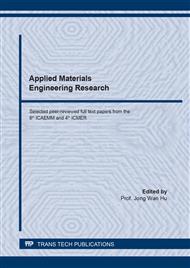[1]
Composites Recycling: where Are We Now, Composites UK Ltd (2016).
Google Scholar
[2]
G. Oliveux, L. O. Dandy, G. A. Leeke, Current status of recycling of fibre reinforced polymers: review of technologies, reuse and resulting properties, Progress in Materials Science (2015).
DOI: 10.1016/j.pmatsci.2015.01.004
Google Scholar
[3]
K.Young-O. Nm Young, Y.K. Seong, P. Min, Y. Beomjoo, K. Jaewoo, C.J. Yong, Application of supercritical water for green recycling of epoxy-based carbon fiber reinforced plastic, Compos. Sci. Technol. 173 (2019) 66–72.
Google Scholar
[4]
G. Oliveux, J. Bailleul, A. Gillet, O. Mantaux, G.A. Leeke, Recovery and reuse of discontinuous carbon fibres by solvolysis: realignment and properties of remanufactured materials, Compos. Sci. Technol. 139 (2017) 99–108.
DOI: 10.1016/j.compscitech.2016.11.001
Google Scholar
[5]
M.L. Longana, H. Yu, J. Lee, K.D. Potter, I. Hamerton, Quasi-isotropic and pseudoductile highly aligned discontinuous fibre composites manufactured with the HiPerDiF (High Performance Discontinuous Fibre) technology, Materials 12 (11) (2019) 1794.
DOI: 10.3390/ma12111794
Google Scholar
[6]
Z. Liu, K. Wong, T. Thimsuvan, T. Turner, S. Pickering, Effect of fibre length and suspension concentration on alignment quality of discontinuous recycled carbon fibre, in: 20th International Conference on Composite Materials, ICCM 2015, 2015, 2015-07-19 - 2015-07-24.
Google Scholar
[7]
P. Aravindan, F. Becagli, M.L. Longana, L.G. Blok, T.R. Pozegic, S.J. Huntley, T. Rendall, I. Hamerton, Remanufacturing of woven carbon fibre fabric production waste into high performance aligned discontinuous fibre composites, J. Compos. Sci. 4 (2020) 68.
DOI: 10.3390/jcs4020068
Google Scholar
[8]
Patent n. 102019000001681, 2019 and Patent n. 102019000001683, (2019).
Google Scholar
[9]
F. David, P. Moretti, V. Tagliaferri, F. Trovalusci¸ FIMEC Test to Evaluate theWater Uptake of Coated and Uncoated CFRP Composites, Materials 13 (2020) 1154;.
DOI: 10.3390/ma13051154
Google Scholar
[10]
J.P. Nunes, J.F. Silva, Sandwiched composites in aerospace engineering, Advanced Composite Materials for Aerospace Engineering, Elsevier, (2016).
DOI: 10.1016/b978-0-08-100037-3.00005-5
Google Scholar


